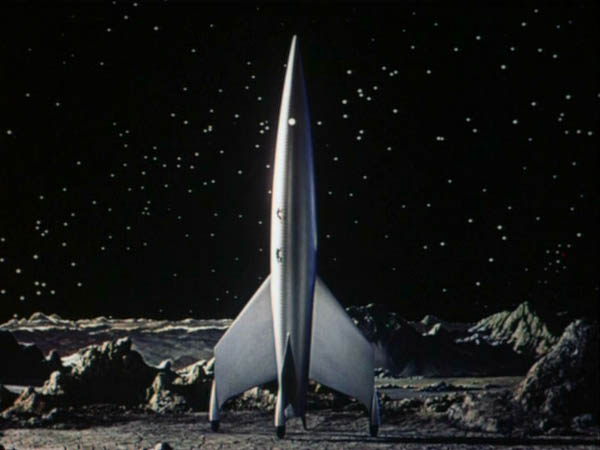



Moon Rocket "Luna"
Web site by: Phil
Broad
Destination Moon is the first serious attempt by filmmakers to show what space flight would be like, made in an age where the technology actually existed to do it (Unlike Fritz Lang's "Frau im Monde" which might well be considered "serious" yet much of the technology required to achieve the flight had to be guessed at). This movie presents us with the reusable nuclear-powered spacecraft "Luna" which is capable of single-stage missions from the Earth to the surface of the Moon and back again. Much of the hardware required for a ship like the Luna had already been made by the time this movie came out (1950) but typically on a smaller scale. Reactors, high-performance rocket engines, compact ultrahigh pressure fuel pumps, sophisticated inertial navigation systems, radar, G-suits, full pressure suits and even integrating computers had all been made and were in use at the time. This meant that for the first time the filmmakers could call upon experts with real-life experience in such fields to provide them with technical advice. Still, what we see in the film is a very simplistic representation of the spacecraft and its technology but what is shown is also technically correct. The opening scenes of the factory were filmed at the Lockheed plant in Burbank, California where we see many of the beautiful four-engined propellor driven "Constellations" on the assembly lines.
The speech made by Mr. Barnes to convince the industrialists to finance the ship still resonates today and may continue to do so for many years to come. The depiction of the ship being built in the desert is quaint but also confusing. By 1950 the techniques for building such a ship were well known, enough so that the filmmakers should have known that such a ship would be built inside a controlled environment, similar to the giant VAB (Vehicle Assembly Building) at Cape Canaveral. Even Fritz Lang accurately showed such a building and those German scientist which were available as consultants at the time actually built such a building at Peenemunde, Germany during WWII. For some reason the filmmakers did not make full use of these advisors yet they were still able to put together a film about space flight that holds together remarkably well, even today.